Whenever an American jury convicts an innocent person, we want to know how twelve intelligent, well-intentioned people got things so wrong. In retrospect, jurors often appear biased, or foolish, or asleep at the switch. But there is a very good reason why jurors drop the ball. Simply put, the emotional rewards of convicting a defendant far outweigh the emotional rewards of a hung jury or an acquittal. I call it the juror’s dilemma.
As head of Friends of Justice, I have spent the past two decades overturning wrongful convictions. Working with friends and family of the accused, dedicated attorneys, resourceful journalists and podcasters, and motivated non-profit organizations, we have accomplished amazing things. Our role is foundational. We explain how an innocent person (or persons) ended up behind bars.
I have already written six posts, beginning with an introduction, explaining how the case against David Black evolved. Now we come to the actual trial. Don’t be concerned if David’s story is new to you. I’ll bring you up to speed as we go. If you want more detail, you find it here, here, here, here and here.
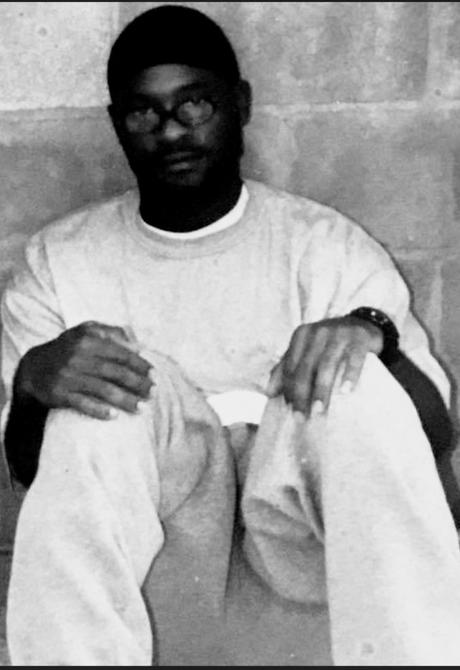
The case against David Black rested on the testimony of two compromised witnesses.
The government’s theory of the crime is quite simple. The drama played out on February 2nd, 1997, in the 400 block of K Street in Washington D.C., less than a mile from the National Mall. At approximately one-thirty in the afternoon, Alice Chow, a beloved 78- year-old member of Washington’s Chinese community, was walking on the southside of K Street, headed for 5th Street, when a bullet entered her left armpit and exited her right armpit. She died on the way to the hospital. (If you are having trouble picturing this tragic event, have no fear, there will be lots of maps below).
Two witnesses, Larry Johnson and Barbara Marshall, explained how Ms. Chow died. Two Black men, David Black (known to the witnesses as “Rob”) and James Smith (known as “June Bug”) were arguing on the north side of K Street, near the hood of a small blue car. As Larry and Barbara looked on, June Bug fled from Rob. Rob circled the blue car, opened the passenger door, pulled out a handgun, sprawled across the roof of the car, and fired two shots. According to the official story, one of those shots killed Alice Chow.
If Larry and Barbara are credible, Rob stayed at the scene for five minutes, then drove away in the blue car.
On all these points, Larry and Barbara were agreed.
Three different Stories
The harder you look at the evidence presented at David Black’s trial, the more confusing the official story becomes. In fact, the jury heard three contradictory stories. Unfortunately, the facts were presented in a hopeless jumble. Let’s sort things out.
Each story presented to the jury possessed three positioinal elements: the position of Alice Chow, the position of Rob (the alleged shooter), and the position of June Bug (the runner). From the prosecution’s perspective, each story possessed certain strengths and weaknesses.
Barbara’s Story
In Barbara’s story, the fight took place directly across the street from Lilly Memorial Baptist Church and June Bug ran down K Street in the direction of “they alley” (the green arrow on the map below). Barbara testified that she didn’t see Alice Chow at all.
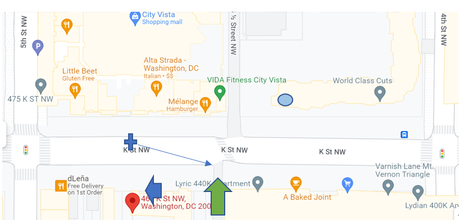
Strengths:
- Since, in all three stories, there is a four or five second lapse between June Bug running and Rob shooting, Barbara’s story provided plenty of time for Rob to fetch a gun from the passenger’s side of the car and fire.
Weaknesses:
- A bullet fired from this position could not have hit Alice Chow (the blue arrow above marks her position according to street witnesses).
- If the bullet did hit Ms. Chow, it would have struck her in the right side, not the left.
- Facial recognition is impossible at 150 feet and Barbara’s story places her 200-250 feet from the shooter.
Larry’s Story:
In the course of his trial testimony, Larry was never asked to describe the position of the various actors, but his grand jury testimony was clear. Alice Chow was in the crosswalk walking toward the apartment building (yellow dot below), June Bug was in the alley running toward Ms. Chow (red dot), and Rob (blue dot) was positioned within five feet of the window where Larry stood watching (green dot).
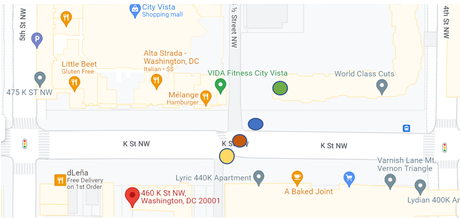
Strengths:
- Larry’s story brings the action right under Larry’s observation point where faces could be recognized.
- In this scenario, a bullet fired by Rob could have struck Ms. Chow.
Weaknesses:
- Street witnesses unanimously place the victim 200 feet to the west of the crosswalk (almost to the church (red pin above).
- In Larry’s story, a bullet fired by Rob (blue dot) would have stuck the victim (yellow dot) on the right side or in the chest, not on her left side (per forensic testimony).
- If Larry’s story is true, Barbara’s story must be false, and vice versa.
The prosecutor’s story:
In his closing statement to the jury, AUSA Whitted created a scenario that departed dramatically from all the testimony presented at trial. By combining elements of Barbara’s story and Larry’s story, Whitted avoided some of the weaknesses in both accounts. In Whitted’s story, Alice Chow was about to cross K Street at the crosswalk (yellow dot below) when the bullet struck her.
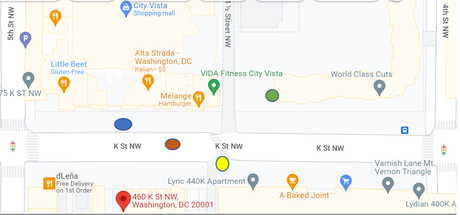
Strengths:
- In Whitted’s story, a bullet fired by Rob (blue dot) at June Bug (red dot) could have struck Alice Chow (yellow dot).
- A bullet fired at this angle could have struck Alice Chow in the left side of her body, consistent with forensic testimony.
Weaknesses:
- Whitted was alleging facts not asserted by any trial witness. Although Larry placed Alice Chow in the crosswalk in his grand jury statement, he never made this claim at trial.
- To make his story work, Whitted had to move Ms. Chow 200 feet to the east of where street witnesses consistently placed her.
- Darrell Haskell (more on him later) testified that he was standing where Whitted’s story places Alice Chow when he heard a pistol round. Haskell didn’t see June Bug, Chow, or David Black.
- Whitted’s story assumes that Ms. Chow was coming home from church. But since the worship service she attended ended two hours before the fatal incident, this couldn’t possibly be true. Street witnesses unanimously testified that Ms. Chow was walking toward 5th street. In other words, she was leaving her apartment, not coming home.
Witnesses on the Run
Over seven months elapsed between the mid-April day when Larry and Barbara testified to a grand jury and the December trial of David Black. As a reward for assisting the Chow investigation, Larry spent this period incarcerated in Hope Village, the only halfway house in the city (he was facing a laundry list of charges that were not adjudicated until the conclusion of Black’s trial). When you are the only person claiming to have observed a crime, you enjoy a great deal of leverage. (As explained in an earlier post, Larry didn’t give David Black’s name to the police; the police gave David’s name to Larry.)
Hope Village residents had to be home by midnight, but were otherwise free to come and go as they pleased. Even so, days before Larry was scheduled to testify to the grand jury in mid-April, he failed to return to Hope House. The police eventually tracked him down and, after a brief conference with prosecutor Kenneth Whitted, deposited him in front of the grand jury.
Larry was rewarded for his grand jury testimony by being returned to Hope House even though he had demonstrated he couldn’t be trusted. Not surprisingly, sometime between his mid-April and early December, Larry escaped a second time. Court records document this second escape, but no details are given.
Barbara Marshall’s story follows a similar pattern. Informed that the trial was scheduled for December, Barbara told prosecutor Whitted that she had decided not to testify. If Whitted put her on the stand, she said, she would recant the story she had told to the grand jury. Moreover, she planned to accuse the police of bullying her into compliance. We know she said this because Whitted forced her to recount the entire story in the presence of the jury.
When Inspector Joe Fox attempted to go over Barbara’s grand jury testimony with her, he received the same treatment.
Fox and Whitted weren’t too worried. They knew Barbara couldn’t change her story without committing perjury, and that would mean serious jailtime.
On December 8th, the first day of David Black’s trial, Steve Roth found a distraught Barbara sitting outside the courthouse cafeteria. Roth introduced himself as an investigator for the defense and asked if she would be willing to give a statement. Without hesitation, Barbara told Roth that she hadn’t seen anything on the day of the shooting. She had seen people running in the street, but this was several minutes after the shooting. She had been unable to identify faces because she wasn’t wearing her glasses.
Larry Johnson couldn’t have seen anything either, she said, because he had spent the night in her apartment and was asleep when she heard gunshots. When Barbara saw police officers entering the building, she woke Larry up and escorted Larry to the nearest elevator. Since he had been barred from entering the building and had missed an important court hearing, he was subject to arrest.
Finally, Barbara explained that she had signed off on Fox’s favored scenario because she was frightened and just wanted to go home. Like Larry, Barbara didn’t identify David as the shooter, she simply agreed (after two days of intense interrogation) to endorse the official story.
Roth jotted down her recantation word-for-word, and then had her read it. Barbara made a couple of inconsequential corrections and signed her name. Then she went into hiding. Whitted had hoped to put her on the stand early in the trial, but it took the police several days to track her down. Barbara ended up being one of the last witnesses to testify.
At trial, both star witnesses both denied seeing the shooting
Larry Johnson had been happy to tell his story to the grand jury. This was likely because he had just escaped from the halfway house and feared he might be sent back to jail. By contrast, his trial testimony was grudging, vague, and riddled with contradictions. He claimed that he had seen Rob and June Bug beefing on the street, but had moved back inside the apartment he was visiting by the time the shooting started.
A startled Ken Whitted was forced to show Larry his grand jury testimony and ask him if he really wanted to change his story. Not wishing to add a perjury charge to the string of felonies he was already facing, Larry reluctantly returned to his original account. Larry’s entire testimony consisted of him either getting the story wrong or not being able to remember anything about the incident. Over and over, Whitted was forced to direct his star witness back to the grand jury transcript.
Most likely, Larry was uncooperative because he honestly couldn’t remember what he had told the grand jury seven months earlier. Not wishing to contradict his earlier story, he repeatedly claimed ignorance of even the most basic facts.
It is also possible that Larry was unnerved by the sight of David Black seated beside his attorney. He had always known that his testimony would send David Black to prison for decades, but the full implications of this fact may not have hit home until he found himself face-to-face with the man he was incriminating.
Barbara Marshall’s testimony got off to a more promising start. She had a good grasp of her grand jury testimony and calmly repeated the official story. She had seen June Bug and Rob fighting. She had seen June Bug in the direction of 4th Street. She had seen Rob retrieve a pistol from the car and fire two or three shots. Then she saw Rob drive away. She wasn’t sure if someone else was driving, she said, but she definitely saw him leave the scene.
When Whitted had completed his examination, defense attorney Thomas Farquhar asked Barbara about the recantation she had dictated to his investigator on the first day of trial. Suddenly, Barbara’s story underwent a 180-degree transformation. She had been in her apartment when she heard gunfire. Since her apartment faces onto a parking lot behind the building, she had no way of knowing what was happening on K Street. So, she opened a window and shouted to a friend who was walking across the lot. The friend had also heard gunfire, but didn’t know where it was coming from.
Farquhar asked Barbara if, as stated in her recantation, she remained in her apartment until police officers came knocking on her door. Yes, she said, that’s what happened. She knew Larry was a wanted man and was eager to get him out of harm’s way.
Then, inexplicably, the defense attorney started insulting and badgering his witness. Hadn’t she told Whitted that Rob was running in the direction of 5th Street (she hadn’t). Barbara reminded Farquhar that June Bug, not Rob, was the man running, and he was headed for “the alley” (that is, in the direction of 4th Street).
Next, Farquhar accused Barbara of claiming that June Bug was running toward Lily Memorial Baptist Church (she hadn’t).
Farquhar’s accusatory tone rekindled Barbara’s trauma and wounded her pride. If what she told Steven Roth was different from what she told Fox and Whitted, she insisted, Roth must have written it down wrong. She was an honest people who always told the truth.
Farquhar reminded his witness that Roth had given her a chance to read over the statement and make corrections. It was too late. All that mattered to Barbara now was defending her own honor.
When Farquhar sat down and it was Whitted’s turn to ask the questions once again, Barbara returned to her original story.
The jury never heard David Black and James “June Bug” Smith testify
Bullying an emotionally fragile witness was a major blunder. Failing to call the two men involved in the altercation on K street proved to be a total disaster.
By keeping his client off the witness stand, Farquhar assured that the jury would never learn that, although David had never done prison time, he had a few minor drug infractions on his record. This small advantage was more apparent than real. Most jurors suspect the worst from a young Black male from a high-crime neighborhood who stands accused of killing an honorable woman.
When a defendant doesn’t testify, jurors always wonder why. Always. They reason that, if they were accused of a serious crime, they would certainly speak in their own defense. When the man on trial stands silent before his accusers, he looks guiltyg. Every single time.
From the time David was arrested in March, 1997 to the time he was convicted nine months later, he was never allowed to tell his own story.
David’s silence wouldn’t have been as damning if James “June Bug” Smith had been called to the stand. Testifying before the grand jury in May, Smith insisted he wasn’t on K Street the day Alice Chow died. He had been near enough to hear gunshots, he said, but had no idea who was shooting.
In addition, June Bug told the grand jury how he had inadvertently implicated David Black. Asked if he knew anyone in the neighborhood who owned a blue car, June Bug said he knew of one person. He didn’t know his actual surname, but his street name was “Black”. He hadn’t been talking about David, he insisted. Everyone knew that Rob drove a red Cadillac.
James “June Bug” Smith spent several days at the courthouse waiting in vain for a chance to set the record straight. In Farquhar’s view, Smith had “too much baggage”. But even if his rap sheet was as extensive as Farquhar implied, his silence bolstered the prosecution’s case.
Street witness testimony doesn’t square with the official story
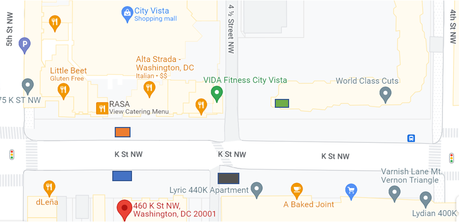
According to Barbara Marshall’s trial testimony, the altercation between “Rob” and “June Bug” (orange rectangle) occurred across the street from Lilly Memorial Baptist Church ( represented by the red pin). Three women testified that they were standing on the sidewalk immediately in front of the church (blue rectangle above) when they heard gunfire and saw Alice Chow fall.
If the violent argument between Rob and June Bug made such a big impression on witnesses located in the apartment building 250 feet away (green box above), it certainly would have captured the attention of three women who were happily conversing just across the street. The women saw nothing. No blue car. No shouting match. No running. No shooting.
It is possible, of course, that the Rob-June Bug dust-up took place immediately in front of the apartment building. This is what Larry told the grand jury. But Darrell Haskell (the man initially identified as the shooter) was standing immediately across the street from the building when he heard a single shot fired (black box above). Like the women in front of the church, Haskell didn’t see a blue car, he didn’t see two men arguing, and he didn’t see anyone fire a gun.
In short, there is a complete disconnect between the events alleged by the government and what the event observed by street witnesses. Larry and Barbara are all over the map. Both witnesses testified that they didn’t see the shooting and that they did. Barbara places the Rob-June Bug argument across the street from the church; Larry locates the altercation right in front of the apartment building (at least 200 feet to the east). The street witnesses, by contrast, told the jury the same exact story.
Police testimony contradicts a central feature of Larry Johnson’s testimony
There were no police officers on the 400 block of K Street when Alice Chow died. But within five minutes of the incident, the area was swarming with law enforcement and EMS personnel. Kimberly Bowman arrived on the scene less than five minutes after the shooting. She saw a crowd of people was gathered around the victim. Ms. Chow had already been placed on a stretcher. Within ten minutes of the shooting, the victim was in an ambulance headed for Howard University Hospital.
Other officers testified that, within ten minutes of the shooting, they had arrested Darrell Haskell at apartment 305.
Larry Johnson consistently testified that, after witnessing the shooting from a hallway window, he rode the elevator to the 6th floor where he briefly compared notes with Barbara Marshall and her friend, Reecie Green. Then Larry and Barbara took the elevator to the lobby, rushed out onto the street, and observed Alice Chow surrounded by a crowd of people. Larry testified that he was back in apartment 305 when the police arrived to arrest Darrell Haskell.
Barbara Marshall was never asked to corroborate this remarkable story. If Barbara confirmed Larry’s account, why didn’t Whitted ask her about it? Either Barbara told Whitted that it never happened, or, inexplicably, he never asked her.
Larry testified that he stood in his hallway window for five minutes after the shooting until Rob finally drove away. By that time, if police officer testimony is to be believed, Alice Chow would have already been removed from the scene.
Larry has also testified that between fifteen and twenty minutes elapsed between the shooting and his arrival on the street with Barbara and Ms. Green. And yet he says he returned to apartment 305 before the police arrived. Since the police arrived at apartment 305 within ten minutes of the shooting, Larry’s timeline is impossible. Again, the story crumbles at the slightest touch. Unfortunately, defense counsel never brought these obvious problems to the attention of the jury. In addition, he never interviewed Barbara’s friend Reecie Green.
A solid alibi
Three members of David Black’s family told the jury that he was with them when Alice Chow died. They were celebrating his sister Kizzie’s birthday, so the date was easy to remember. Kenneth Whitted questioned each alibi witness, probing for inconsistencies. None emerged. David had been with them all afternoon and well into the evening. If they were lying to protect a loved one, it was an impressive performance. By finding David Black guilty, the jury had to conclude that his alibi witnesses were liars.
Hopelessly deadlocked
According to trial transcripts, the jury struggled with the David Black case. After several hours of deliberation, they sent a note to the judge saying that they were hopelessly deadlocked. The jury may have been split 6-to-6 or 4-to-8. It is more likely, however, that only one of two jurors had serious misgivings.
When the judge told the jurors to keep working, they asked him for a definition of “reasonable doubt”. Shortly thereafter after receiving an answer, they had reached a verdict.
It is shocking that a case resting on the credibility of two comically compromised witnesses ever made it to trial. When both key witnesses state flatly that they didn’t actually witness the incident then say the exact opposite, reasonable doubt is cooked into the judicial pie.
Perjury and obstruction of justice
The prosecution argued that Larry and Barbara were afraid to implicate the defendant because they feared retaliation. But were they afraid of David Black, or did they fear the consequences of angering the government? If they were afraid of David, they would have said whatever was most likely to keep him behind bars for the rest of his life.
We don’t know what Kenneth Whitted told his star witnesses behind closed doors, but we can be pretty sure. By the time he took the stand at David’s trial, Larry had already escaped from prison on two occasions and was facing several other criminal charges. Barbara had defied a subpoena by going into hiding on the first day of trial. All would be forgiven if they stuck with the government’s story. But if they contradicted that story, both witnesses were facing serious time in prison. You can be sure that Whitted described their predicament in the starkest terms possible.
Perjury (intentional false testimony) is taken very seriously by the judicial system. In a case this sensitive, Larry and Barbara faced up to five years in prison. It is difficult to testify honestly with the sword of Damocles hovering over your head.
In most cases, jurors have little grasp of these realities.
The juror’s dilemma
When the crime is heinous and the facts are ambiguous, criminal cases often hinge on raw emotion. The emotional rewards of a guilty verdict greatly outweigh the feel-good effect of an acquittal.
From a juror’s perspective, prosecutors play for Team America and speak from conviction; defense attorneys are viewed as hired mercenaries doing a nasty job. You can’t find a defendant not guilty without tacitly accusing the police and the prosecution of serious misconduct.
Neither Judge Herbert Dixon, Assistant US Attorney Kenneth Whitted, lead investigator Joseph Fox, or defense attorney Thomas Farquhar ever understood what was being alleged in this case. They were too busy to appreciate the huge gap between Larry’s testimony and Barbara’s, to grasp just how frequently both witnesses contradicted themselves, or to ask themselves why these people were so afraid of testifying. No one asked how many hours Barbara spent in police custody before breaking down, or why, in the first few weeks of the investigation, Larry falsely implicated several innocent people in the death of Alice Chow.
All they knew was that two people said they saw the defendant fire a gun on K Street seconds before Alice Chow slumped to the round. The Metropolitan Police Department had a scandalously poor record of closing murder cases in the late 1990s. The public was demanding justice for Alice Chow and, if the killer wasn’t David Black, the case was headed for the cold case file.
It is equally clear that Dixon, Whitted, Fox and Farquhar lived inside an echo chamber. No one had the time or inclination to ask hard questions, so they took their cues from one another.
The jury likely concluded that all the authority figures in the courtroom believed David was guilty. Sure, Farquhar was going through the motions, but if he really thought his client was innocent he would have prepared for trial. He was asking questions off the top of his head. He had no discernible trial strategy. He frequently misstated the facts. He failed to call critically important witnesses.
An acquittal, therefore, would have been construed as an indictment of the entire legal system. You couldn’t vote to acquit without concluding that the men on Team USA were guilty of gross misconduct. Most jurors are unprepared to send a message of such gravity.
But there is a second aspect to the juror’s dilemma. A guilty verdict gave the community the closure it craved; an acquittal or a not-guilty verdict would have deprived Alice Chow of the justice she deserved. No one would question a guilty verdict, low-status defendants almost never beat a federal indictment. Unless a case has generated national publicity, the media generally show up for opening arguments and disappear until the verdict is announced (if they show up at all). A not guilty verdict would have left the citizenry with a mouthful of ashes.
It is unspeakably difficult for a single individual to hang a jury. Eleven jurors are eager to see justice served (even if that means giving people like Larry and Barbara a pass); the lone holdout is frustrating that desire. Only the rarest of individuals can withstand that kind of pressure.
These emotional realities are in play in every trial; but in the David Black trial, the stakes were unusually high.
Where from here?
Once an innocent defendant has been convicted by a jury, the mischief is extraordinarily difficult to undo. Technical and procedural issues can be raised on appeal, but the validity of a jury verdict cannot be questioned.
Yet I believe justice is coming for David Black. The case is too stupid, too ridiculous, too bizarre and, frankly, too obscene to stand.
That said, I am quite sure the jurors in this case were well-intentioned, diligent and reasonably intelligent. If the jurors in this case were exposed to my critique, I suspect some of them would have serious second thoughts. Tragically, the fatal flaws in the government’s case weren’t exposed at trial.
Neither do I blame Thomas Farquhar, David’s (now deceased) defense attorney, for the outcome. In the course of David Black’s trial, Farquhar repeatedly asked Judge Dixon to delay the proceedings so he could speak to other judges in the building about other cases. To survive financially, defense attorneys are typically forced to take far more cases than they can realistically handle. The vast majority of cases end in plea bargain. The rare case that goes to trial generally receives little attention until the last minute. This was certainly true in the Black case. In a pretrial hearing, Farquhar skimmed through police reports he had never read before even as he put questions investigator Joe Fox. Farquhar had a vague grasp of the grand jury testimony in the Black case, but he lacked the time required to spot problems and inconsistencies. Since he had no time to vet potential witnesses, he simply didn’t call them.
In short, Thomas Farquhar was a typical overworked and underpaid defense attorney. He did the best he could under the circumstances, but it wasn’t nearly enough.
I am not an attorney. My voice, in isolation, can’t win justice for David Black. But facts this bad, once exposed, typically invite concerted pushback. The justice coalition David Black deserves is taking shape. I promise to keep you posted.
Email Address:
- The Juror’s Dilemma: probing the wrongful conviction of David Black
- Herschel Walker and the Hollow Men
- Please Lie to Me: The David Black Story (Part 5)
- The David Black Story: An Introduction
- Gaslighting: The David Black Story (part four)
